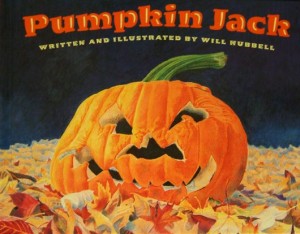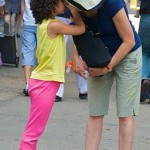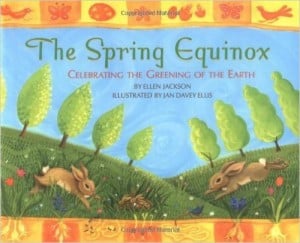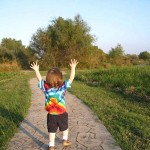by Meg Yardley
There are a lot of wonderful children’s picture books to read at this time of year, though I haven’t found any specifically about Samhain (either the historical Celtic or modern neo-Pagan version). Some good themes for picture books to celebrate this festival include:
- Death, dying, and staying connected to loved ones after loss (when addressed in an age-appropriate way)
- Other worlds (the land of Faerie, Avalon, the spirit world or any other place beyond) – again, in an age-appropriate way which will not be too scary for your child’s developmental stage
- Día de los Muertos. This holiday comes out of pre-Columbian celebrations (in Mexico and parts of Central and South America) combined with the Catholic feast of All Saints’ Day. All Saints’ Day may have been originally assigned to its current date in order to coincide with the older Celtic feast of Samhain. So although current celebrations of el Día de los Muertos and Samhain come out of different cultural contexts, they do have some common ancestry way back when, and they certainly have similar themes and meanings.
- Halloween. However you feel about Halloween as a modern-day Samhain, it’s one of the more Pagan mainstream holidays and there are a lot of fun books which have a nice seasonal flavor to them. Though there are many Halloween books about witches, stories that depict witches in a positive light are few. So it’s important to seek out positive portrayals and start general conversations about the topic of “What is a witch?” and “What is the difference between real witches and the witches we see in books?” This brings me to my first book recommendation:
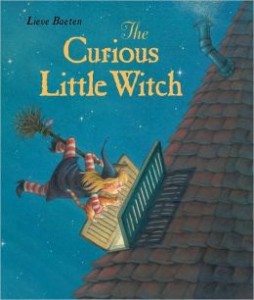
“The Curious Little Witch” by Lieve Baeten
Curious little witch Lizzie accidentally crashes her broomstick into the attic of a house, and as she wanders through the house searching for someone to fix her broomstick, she meets the various witches who live there: the Kitchen Witch, the Music Witch, and so on. Finally, in the basement, she meets the Tinkering Witch who is able to fix up her broomstick – with improvements. This story has good pacing – relaxed but keeping the reader’s interest – and the illustrations are a lot of fun (every picture has some small funny details to notice). It has a classic “Halloween” feel (witches, broomsticks, full moon, and spooky old house). Appropriate for older toddlers and up.
Pagan Notes: What I love about this book from a Pagan perspective is not just the positive, friendly portrayal of witches, but the variety of types of magic they work. When my preschooler says something about witches (usually in a scary fantasy context), I reply by asking, in the most curious tone I can summon, “What kind of witch?” This book helps me to broaden the question: not just a nice witch vs. a mean witch, but could it be a kitchen witch? a music witch? (As a side note, only a Belgian book would feature an awesome Tinkering Witch who fixes all kinds of things with her tools while wearing a long skirt and high heels. I love it.)
This lovely book starts with a boy who carves a pumpkin and names it Jack. He puts it out in the garden when it starts to rot. Over time, he watches what happens to the pumpkin as the seasons change: it rots, is buried in snow, reappears (mostly gone), and then reappears in the form of a seedling, which grows a new pumpkin plant, which produces many new pumpkins, and Jack gets to carve a new Pumpkin Jack. The sweet story is anchored by the beautifully detailed and realistic illustrations portraying a half-rotted pumpkin, a plant after the first frost, a flourishing yellow pumpkin blossom. I felt like I was looking out into my own garden.
Pagan Notes: The combination of Halloween mood and a lesson on the cycle of life, death, and rebirth make this a perfect Samhain read. I loved the very precise relationship with nature (i.e. not just general “plants” but following a specific plant through the cycle; and not just generally “oh, it goes back to the earth” but showing the stages in the process). This could be a great conversation-starter about the cycle of human life as well.
Tess’s Tree, by Jess M. Brallier 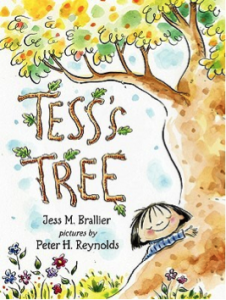
Tess’s beloved backyard tree has to be cut down and Tess goes through various stages of mourning its loss. Finally she organizes a community event – a funeral for her tree – which brings together her friends, neighbors, and everyone whose life has been touched by her tree. The funeral allows her (and others) to make peace with the loss of her tree. This story vividly portrays how much joy Tess gets out of her tree and how much sadness she feels when it is taken away.
Pagan Notes: This book isn’t explicitly Pagan but it celebrates the life cycle of a tree throughout the seasons, as well as the profound ways in which people are connected to nature and a sense of place. This sweet book is a great introduction to grief and loss, without being too intense, and a great way to start conversations about death and dying as we prepare to honor those we have lost at Samhain.
Felipa and the Day of the Dead, by Birte Muller
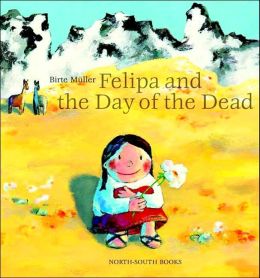 Young Felipa, living in a village high in the Bolivian Andes, is mourning the loss of her dear Abuelita. She seeks to understand where Abuelita’s soul has gone, and looks around in various places before her parents help her to understand that on the Day of the Dead, Abuelita’s soul will come back to the village to visit when they honor her spirit. The drawings are colorful, childlike, and evocative. The simple language and short length of this book make it appropriate for toddlers and up, but the complex questions it raises will keep your preschooler or older child engaged as well. I felt this book addressed death in a developmentally accurate way for a young child: first Felipa’s attempt to seek a concrete location for Abuelita’s soul, and then her realization that special rituals and practices can bring the comfort of feeling close to her Abuelita once again.
Young Felipa, living in a village high in the Bolivian Andes, is mourning the loss of her dear Abuelita. She seeks to understand where Abuelita’s soul has gone, and looks around in various places before her parents help her to understand that on the Day of the Dead, Abuelita’s soul will come back to the village to visit when they honor her spirit. The drawings are colorful, childlike, and evocative. The simple language and short length of this book make it appropriate for toddlers and up, but the complex questions it raises will keep your preschooler or older child engaged as well. I felt this book addressed death in a developmentally accurate way for a young child: first Felipa’s attempt to seek a concrete location for Abuelita’s soul, and then her realization that special rituals and practices can bring the comfort of feeling close to her Abuelita once again.
Pagan Notes: As I mentioned above, learning about the Day of the Dead can be a wonderful way to make cross-cultural connections while introducing the importance of honoring our ancestors. This book raises some questions about where the soul lives, and doesn’t completely answer them, which I really appreciated – it feels like there is plenty of room to consider different possibilities.
Prietita and the Ghost Woman, by Gloria Anzaldúa 
In this bilingual picture book by Chicana literary legend Gloria Anzaldúa (with gorgeous, vivid illustrations by Maya Christina Gonzalez), the young Prietita goes in search of an herb for her sick mother. When she gets lost in unknown woods in the dark, she encounters La Llorona (a weeping woman from Mexican legend who steals children away). However, instead of stealing her away, La Llorona leads Prietita to the herb she needs, then guides her back home. In this adventure story, Prietita is frightened by the dangers she encounters, but holds strongly to her values and gets help from trusted elders. Recommended for Kindergarten and up. (The mood of this book is not overall very frightening but it does include a few dangers, most notably the references to La Llorona stealing children, and also the forest where “they shoot trespassers” and “it’s not safe for a young girl”. I edited a few sentences for my preschooler. Also, If your child has a stronger cultural association with how scary La Llorona is, they might find this scarier than my child did!)
Pagan Notes: This book is about ghosts, magic, healing, bravery, and going into a dark wood at night: in short, a perfect Samhain story! The story features a healer/herbalist, the curandera, who is a powerful and positive witchy figure. I enjoyed Gloria Anzaldúa’s revisioning of La Llorona – she comments in a note at the back of the book that she had always wondered if there was “another side” to this otherwise frightening figure.
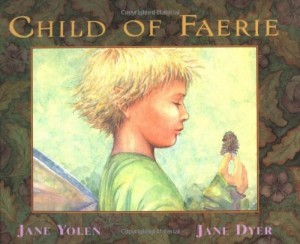 Child of Faerie, Child of Earth, by Jane Yolen
Child of Faerie, Child of Earth, by Jane Yolen
Well-known fantasy author Jane Yolen wrote this narrative poem telling the story of a child of Faerie and a human child who make friends one Hallowmas evening and visit each other’s different realms during the course of the night. The beautiful illustrations have a nostalgic 19th-century feel. Although some of the vocabulary will be beyond younger readers, the story is not hard to follow. The book is full of vividly illustrated contrasts between Earth and the land of Faerie; it is otherworldly enough to create a slightly eerie mood, but down-to-earth enough to be fun rather than scary.
Pagan Notes: This book takes place on Samhain (“Hallowmas” in the text) and illustrates the idea that “the veil between the worlds is thin” on this night. Most stories about humans being spirited off to faerie kingdoms don’t end well, so I loved that this one features a sweet human-faerie friendship and ends with the advice that if you see faeries dancing in a ring, you should join in!
Editor’s Note: You can order all these books (+ every other book we’ve ever reviewed at Pagan Families) from our bookstore.

